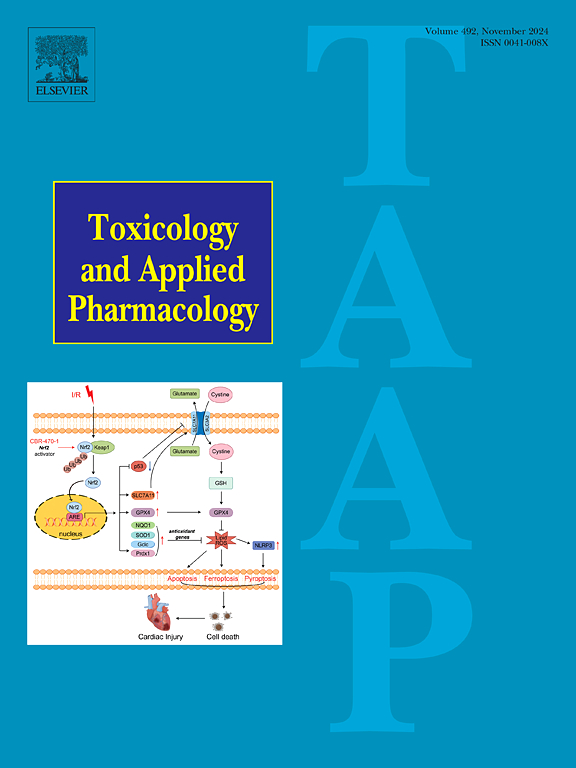阿魏酸对小鼠应激性心肌损伤有保护作用
IF 3.3
3区 医学
Q2 PHARMACOLOGY & PHARMACY
引用次数: 0
摘要
过度的压力是心血管疾病(CVD)的一个已知因素,阿魏酸(FA)是一种天然酚类化合物,已被证明具有显著的抗氧化和抗炎特性。本研究探讨了FA对应激性心肌损伤(SIMI)的保护作用,并阐明了其潜在机制。采用低温水浸泡法建立小鼠急性SIMI模型。通过心脏指数和组织病理学分析评估心功能。采用酶联免疫吸附法(ELISA)定量测定血清皮质酮(CORT)、乳酸脱氢酶(LDH)和脑利钠肽(BNP)水平,以及炎症标志物TNF-α和IL-1β。采用比色法和荧光探针分析氧化应激参数,包括丙二醛(MDA)、谷胱甘肽(GSH)、超氧化物歧化酶(SOD)和活性氧(ROS)。采用免疫组织化学(IHC)和Western Blot分析TNF、MAPK、PPAR-α/PGC-1α和Nrf2信号通路相关蛋白的表达。结果表明,FA预处理可改善心脏指数和心肌结构完整性,减少炎症细胞浸润。fa处理的SIMI小鼠血清LDH、BNP、CORT、TNF-α和IL-1β水平显著降低。FA预处理可能通过激活PPARα/PGC-1α和Nrf2信号通路,逆转了SIMI组MDA和ROS水平升高以及GSH和SOD水平降低。此外,FA抑制TNF-α/TNFR1和ERK/JNK MAPK通路,有助于其保护作用。总之,FA通过减轻氧化应激和炎症反应来减轻SIMI。本文章由计算机程序翻译,如有差异,请以英文原文为准。
Ferulic acid protects against stress-induced myocardial injury in mice
Excessive stress is a known contributor to cardiovascular diseases (CVD), and ferulic acid (FA), a natural phenolic compound, has demonstrated significant antioxidant and anti-inflammatory properties. This study investigates the protective effects of FA against stress-induced myocardial injury (SIMI) and elucidates the underlying mechanisms. An acute SIMI model was established in mice using low-temperature water immersion restraint. Cardiac function was assessed via cardiac index and histopathological analysis. Serum levels of corticosterone (CORT), lactate dehydrogenase (LDH), and brain natriuretic peptide (BNP) were quantified using enzyme-linked immunosorbent assay (ELISA), along with inflammatory markers TNF-α and IL-1β. The oxidative stress parameters, including malondialdehyde (MDA), glutathione (GSH), superoxide dismutase (SOD), and reactive oxygen species (ROS), were analyzed using colorimetric methods and fluorescent probes. Immunohistochemistry (IHC) and Western Blot were used to analyze the expression of proteins related to TNF, MAPK, PPAR-α/PGC-1α, and Nrf2 signaling pathways. Results indicated that FA pretreatment improved cardiac index, myocardial structural integrity, and reduced inflammatory cell infiltration. Serum levels of LDH, BNP, CORT, TNF-α, and IL-1β were significantly decreased in FA-treated SIMI mice. Elevated MDA and ROS levels, along with decreased GSH and SOD levels in the SIMI group, were reversed by FA pretreatment, likely through activation of the PPARα/PGC-1α and Nrf2 signaling pathways. Additionally, FA inhibited the TNF-α/TNFR1 and ERK/JNK MAPK pathways, contributing to its protective effects. In conclusion, FA mitigates SIMI by alleviating oxidative stress and inflammatory responses.
求助全文
通过发布文献求助,成功后即可免费获取论文全文。
去求助
来源期刊
CiteScore
6.80
自引率
2.60%
发文量
309
审稿时长
32 days
期刊介绍:
Toxicology and Applied Pharmacology publishes original scientific research of relevance to animals or humans pertaining to the action of chemicals, drugs, or chemically-defined natural products.
Regular articles address mechanistic approaches to physiological, pharmacologic, biochemical, cellular, or molecular understanding of toxicologic/pathologic lesions and to methods used to describe these responses. Safety Science articles address outstanding state-of-the-art preclinical and human translational characterization of drug and chemical safety employing cutting-edge science. Highly significant Regulatory Safety Science articles will also be considered in this category. Papers concerned with alternatives to the use of experimental animals are encouraged.
Short articles report on high impact studies of broad interest to readers of TAAP that would benefit from rapid publication. These articles should contain no more than a combined total of four figures and tables. Authors should include in their cover letter the justification for consideration of their manuscript as a short article.

 求助内容:
求助内容: 应助结果提醒方式:
应助结果提醒方式:


